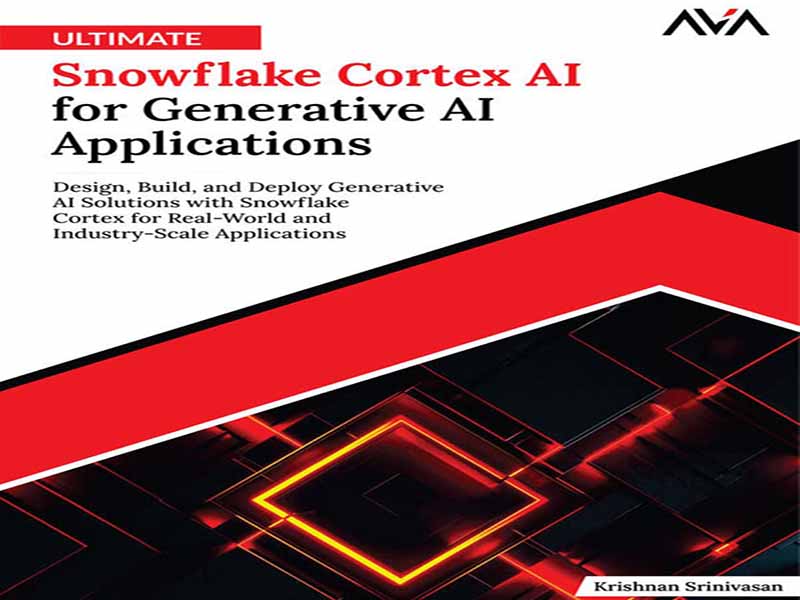- عنوان کتاب: Ultimate Snowflake Cortex AI for Generative AI Applications
- نویسنده: Krishnan Srinivasan
- حوزه: هوش مصنوعی مولد
- سال انتشار: 2025
- تعداد صفحه: 458
- زبان اصلی: انگلیسی
- نوع فایل: pdf
- حجم فایل: 6.63 مگابایت
این کتاب، یک راهنمای جامع و کاربردی است که برای دانشمندان داده، مهندسان، تحلیلگران، متخصصان داده و رهبران کسبوکار که به دنبال بهرهبرداری از پتانسیل کامل هوش مصنوعی مولد در موتور هوش مصنوعی بومی قدرتمند Snowflake Cortex هستند، طراحی شده است. این کتاب به طور عمیق به قابلیتهای Cortex میپردازد و خوانندگان را به دانش و ابزارهای مورد نیاز برای طراحی، ساخت و استقرار برنامههای پیشرفته هوش مصنوعی مولد و یادگیری ماشین مجهز میکند. از مفاهیم بنیادی گرفته تا موارد استفاده پیشرفته، این کتاب یک رویکرد ساختاریافته و عملی برای استفاده از پلتفرم ابری داده یکپارچه Snowflake برای توسعه هوش مصنوعی مدرن ارائه میدهد. چه هدف شما افزایش بهرهوری از طریق اتوماسیون هوشمند، استخراج بینش از دادههای بدون ساختار، ساخت LLM های خاص دامنه، پیادهسازی پردازش هوشمند اسناد، تنظیم دقیق مدلها برای موارد استفاده خاص یا هماهنگسازی گردشهای کاری هوش مصنوعی با استفاده از عوامل Snowflake باشد، این کتاب به عنوان همراه ضروری شما عمل میکند. همچنین به تعمیق درک شما از برنامههای کاربردی صنعت در دنیای واقعی کمک میکند و شما را در سفر به سوی نوآوری مبتنی بر هوش مصنوعی در اکوسیستم Snowflake راهنمایی میکند. این کتاب در ۱۱ فصل جامع سازماندهی شده است که به شرح زیر فهرست شدهاند: فصل ۱. مقدمهای بر هوش مصنوعی/یادگیری ماشین در اکوسیستم اسنوفلیک: این فصل بنیادی، خوانندگان را با دنیای هوش مصنوعی و یادگیری ماشین آشنا میکند و مفاهیم اصلی مانند یادگیری عمیق، پردازش زبان طبیعی و بینایی کامپیوتر را توضیح میدهد. همچنین تکامل هوش مصنوعی مولد و تأثیر رو به رشد آن در صنایع مختلف را ارائه میدهد. این فصل با بررسی معماری اسنوفلیک و نحوه پشتیبانی آن از ابتکارات مقیاسپذیر هوش مصنوعی و یادگیری ماشین از طریق ابزارهای بومی خود و مروری مختصر بر Snowpark ML به پایان میرسد. فصل ۲. درک Snowflake Cortex: این فصل نگاهی عمیق به Snowflake Cortex میاندازد و ویژگیهای کلیدی و اجزای داخلی آن را که توسعه هوش مصنوعی/یادگیری ماشین را در اکوسیستم اسنوفلیک قابل دسترستر میکند، شرح میدهد. این فصل، Cortex را با خطوط لوله سنتی یادگیری ماشین مقایسه میکند و بر مزایای آن از نظر سرعت، مقیاسپذیری و سادگی تأکید میکند. خوانندگان در مورد چگونگی ادغام یکپارچه Cortex در گردشهای کاری دادههای سازمانی، شفافسازی خواهند کرد. فصل ۳. مروری بر توابع یادگیری ماشین: این فصل بر توابع اصلی یادگیری ماشین که به صورت بومی در Snowflake موجود هستند، از جمله طبقهبندی، پیشبینی، تشخیص ناهنجاری و استخراج بینشهای برتر، تمرکز دارد. این فصل نشان میدهد که چگونه میتوان از این توابع برای پرداختن به مشکلات تجاری دنیای واقعی استفاده کرد و راحتی کار با یادگیری ماشین را در یک پلتفرم واحد و تحت کنترل با استفاده از Cortex و AI & ML Studio به نمایش میگذارد. فصل ۴. مقدمهای بر LLMها، مهندسی سریع و RAG: این فصل با پوشش اصول اولیه آنها، همراه با تکنیکهایی مانند مهندسی سریع و بازیابی تولید افزوده (RAG)، زمینه را برای کار با مدلهای زبان بزرگ (LLM) فراهم میکند. این فصل بررسی میکند که چگونه جستجوی مبتنی بر جاسازی و پایگاههای داده برداری نقش حیاتی در تقویت LLMها ایفا میکنند و راه را برای بازیابی اطلاعات آگاهتر از متن و کارآمدتر هموار میکنند. فصل 5. توابع LLM در Cortex AI: این فصل که به قابلیتهای LLM در Snowflake Cortex اختصاص دارد، نشان میدهد که چگونه کاربران میتوانند به طور یکپارچه LLMهای از پیش آموزشدیده را برای خلاصهسازی، تحلیل احساسات، ترجمه و موارد دیگر فراخوانی کنند. این فصل مدلهای استفاده، دسترسی منطقهای و ملاحظات هزینه را پوشش میدهد و به خوانندگان کمک میکند تا درک کنند که چگونه LLMها از طریق Cortex برای موارد استفاده در سطح سازمانی دموکراتیزه میشوند. فصل 6. تنظیم دقیق مدلهای زبان بزرگ در Cortex: در این فصل، خوانندگان یاد میگیرند که چرا و چگونه LLMها را با استفاده از Snowflake Cortex تنظیم دقیق کنند. این فصل استراتژیهای مختلف تنظیم دقیق، از تنظیم دستورالعمل گرفته تا تنظیمات خاص دامنه را بررسی میکند و یک مرور معماری از فرآیند تنظیم دقیق ارائه میدهد. این فصل همچنین مزایای مدلهای هوش مصنوعی شخصیسازی شده و چگونگی دستیابی ایمن سازمانها به آنها در Cortex را مورد بحث قرار میدهد. فصل 7. پرسوجوهای زبان طبیعی به بینشهای عملی: این فصل به بررسی قابلیتهای Snowflake برای تبدیل سوالات زبان ساده به بینشهای دادهمحور میپردازد. این کتاب ابزارهایی مانند Cortex Analyst، Cortex Search و SQL Copilot را معرفی میکند که به کاربران امکان میدهد با استفاده از زبان طبیعی با دادههای ساختاریافته و بدون ساختار تعامل داشته باشند. همچنین مفهوم عاملهای هوش مصنوعی که این تعاملات را در پشت صحنه هماهنگ میکنند، مورد بحث قرار میگیرد. ما همچنین به Cortex LLM Playground، یک محیط تعاملی در Snowflake برای آزمایش سریع مدلهای زبانی بزرگ با استفاده از زبان طبیعی، خواهیم پرداخت که آزمایش ایدهها و اعتبارسنجی بینشهای مبتنی بر هوش مصنوعی را بدون کدنویسی گسترده آسان میکند. فصل 8. باز کردن قفل هوش اسناد با هوش مصنوعی اسناد: در اینجا، کتاب به هوش مصنوعی اسناد و پتانسیلی که برای تبدیل اسناد بدون ساختار به دادههای ساختاریافته و کاربردی به ارمغان میآورد، میپردازد. این فصل شامل راهنماییهای پیادهسازی، بهترین شیوهها و موارد استفاده در دنیای واقعی است که صنایعی مانند امور مالی، حقوقی و مراقبتهای بهداشتی را در بر میگیرد. فصل 9. پیادهسازی Cortex با امنیت، حاکمیت و انضباط هزینه: این فصل تضمین میکند که …
This book is a comprehensive and practical guide tailored for data scientists, engineers, analysts, data professionals and business leaders seeking to harness the full potential of Generative AI on Snowflake Cortex—Snowflake’s powerful native AI engine. This book delves deep into the capabilities of Cortex, equipping readers with the knowledge and tools needed to design, build, and deploy cutting-edge Generative AI and Machine Learning applications. From foundational concepts to advanced use cases, it provides a structured and hands-on approach to leveraging Snowflake’s unified data cloud platform for modern AI development. Whether you are aiming to enhance productivity through intelligent automation, derive insights from unstructured data, build domain-specific LLMs, implement intelligent document processing, fine-tune models for specific use cases, or orchestrate AI workflows using Snowflake agents, this book serves as your essential companion. It also helps deepen your understanding of realworld industry applications, guiding you on the journey toward AI-driven innovation within the Snowflake ecosystem. This book is organized into 11 comprehensive chapters, listed as follows: Chapter 1. Introduction to AI/ML in the Snowflake Ecosystem: This foundational chapter introduces readers to the world of Artificial Intelligence and Machine Learning, explaining core concepts such as Deep Learning, Natural Language Processing, and Computer Vision. It also presents the evolution of Generative AI and its growing impact across industries. The chapter concludes by exploring Snowflake’s architecture and how it supports scalable AI and ML initiatives through its native tools with a brief overview of Snowpark ML. Chapter 2. Understanding Snowflake Cortex: This chapter provides a deep dive into Snowflake Cortex, outlining its key features and internal components that make AI/ML development more accessible within the Snowflake ecosystem. It compares Cortex with traditional ML pipelines and emphasizes its advantages in terms of speed, scalability, and simplicity. Readers will gain clarity on how Cortex seamlessly integrates into enterprise data workflows. Chapter 3. Overview of Machine Learning Functions: This chapter focuses on the core ML functions natively available in Snowflake, including classification, forecasting, anomaly detection, and extracting top insights. It demonstrates how these functions can be used to address real-world business problems and showcases the convenience of operating ML within a single, governed platform using Cortex and the AI & ML Studio. Chapter 4. Introduction to LLMs, Prompt Engineering, and RAG: This chapter sets the stage for working with Large Language Models (LLMs) by covering their fundamentals, along with techniques such as prompt engineering and Retrieval Augmented Generation (RAG). It explores how embedding-based search and vector databases play a vital role in augmenting LLMs, paving the way for more context-aware and efficient information retrieval. Chapter 5. LLM Functions in Cortex AI: Dedicated to Snowflake Cortex’s LLM capabilities, this chapter highlights how users can seamlessly invoke pre-trained LLMs for summarization, sentiment analysis, translation, and more. It covers usage models, regional availability, and cost considerations, and helps readers understand how LLMs are democratized through Cortex for enterprise-grade use cases. Chapter 6. Fine-Tuning Large Language Models in Cortex: In this chapter, readers learn why and how to finetune LLMs using Snowflake Cortex. It explores various finetuning strategies, from instruction tuning to domainspecific adjustments, and provides an architectural overview of the finetuning process. The chapter also discusses the benefits of personalized AI models and how organizations can achieve them securely within Cortex. Chapter 7. Natural Language Queries to Actionable Insights: This chapter explores Snowflake’s capabilities for turning plain-language questions into data-driven insights. It introduces tools such as Cortex Analyst, Cortex Search, and SQL Copilot, which allow users to interact with structured and unstructured data using natural language. It also discusses the concept of AI agents that orchestrate these interactions behind the scenes. We will also look at the Cortex LLM Playground, an interactive environment within Snowflake for quickly testing large language models using natural language, making it easy to test ideas and validate AI-driven insights without extensive coding. Chapter 8. Unlocking Document Intelligence with Document AI: Here, the book dives into Document AI and the potential it brings for transforming unstructured documents into structured, actionable data. The chapter covers implementation guidance, best practices, and realworld use cases that span industries such as finance, legal, and healthcare. Chapter 9. Implementing Cortex with Security, Governance, and Cost Discipline: This chapter ensures that readers understand the importance of secure and responsible AI practices. It covers security and governance best practices, strategies for cost optimization, and tools for AI observability in Cortex. It is a must-read for those planning to deploy AI at enterprise scale. Chapter 10. Industry Use Cases and Case Studies: Bringing everything together, this chapter presents a wide array of industry-specific use cases implemented with Cortex. These examples—ranging from customer sentiment analysis, predictive maintenance, social media analytics, and student performance analysis illustrate the versatility of Cortex. The fictional company Zentime is used throughout the book as a unifying thread to illustrate and contextualize AI applications. We will conclude by summarizing the key generative AI features within Cortex that enable these diverse and impactful solutions. Chapter 11. Conclusion and Next Steps: The final chapter reflects the journey through Cortex AI, summarizing the key takeaways from each chapter. It also highlights future trends and provides practical next steps for readers to begin or accelerate their AI transformation journey using Snowflake Cortex.
این کتاب را میتوانید از لینک زیر بصورت رایگان دانلود کنید:
Download: Ultimate Snowflake Cortex AI for Generative AI Applications




































نظرات کاربران